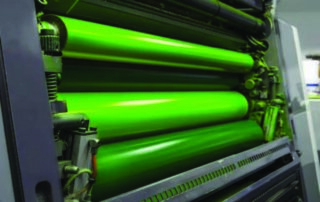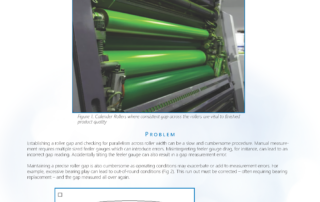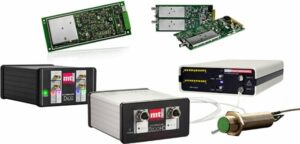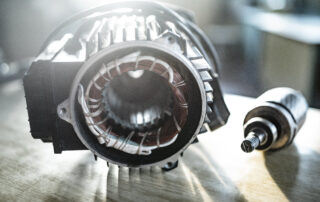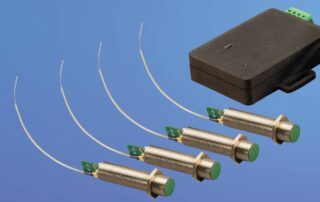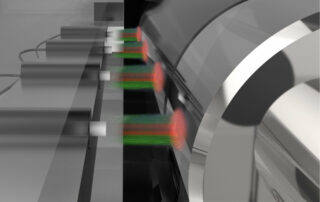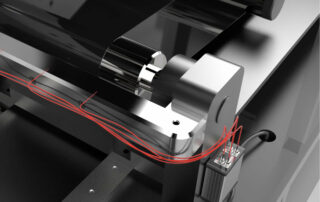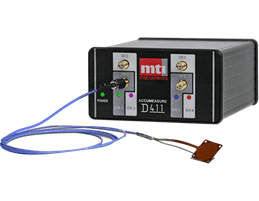Blogs
MTI Application Note: How to Achieve <1um Accuracy When Measuring Roller Gap
How to Achieve <1um Accuracy When Measuring Roller Gap Roller Gap Measurement with MTI Digital Accumeasure Capacitive Probes Many roll-to-roll finishing processes typically use a calender, or series of hard pressure rollers, to deliver smooth, high-quality products of plastic, textile, or paper (Fig 1). Ensuring a consistent material thickness, however, depends on the ability to monitor, and maintain, a precise gap between rollers. This application note describes a quick and easy means for roller gap measurement. Problem How to measure the small gap between rollers to keep track of product thickness. Typically, it’s not possible to [...]
MTI Case-In-Point: Gap Monitor Keeps Wind Turbines Running
Gap Monitor Keeps Wind Turbines Running System helps operators minimize downtime and protect against catastrophic failure Introduction Wind turbine production has been steadily increasing to meet growing demand for renewable energy. As power outputs and the number of installations climb, maintenance becomes ever more critical. Operators want to minimize downtime and protect against catastrophic failure. The ability to predict when maintenance will be required can go a long way to ensure these goals are met. Challenge A leading manufacturer of wind turbine power generators approached MTI for critical gap monitoring sensors. Specifically, the company wished to [...]
MTI Whitepaper: Easy Roller Gap Measurement Ensures Calendering Success
Easy Roller Gap Measurement Ensures Calendering Success Many roll-to-roll finishing processes typically use a calender, or series of hard pressure rollers, to deliver smooth, high-quality products of plastic, textile, or paper (Fig 1). Ensuring a consistent material thickness, however, depends on the ability to monitor, and maintain, a precise gap between rollers. This application note describes a quick and easy means for roller gap measurement Problem Establishing a roller gap and checking for parallelism across roller width can be a slow and cumbersome procedure. Manual measurement requires multiple sized feeler gauges which can introduce errors. Misinterpreting [...]
A Comprehensive Guide to Non-Contact Sensors and Their Applications
A Comprehensive Guide to Non-Contact Sensors and Their ApplicationsSensors, both contact and non-contact, are crucial devices that allow the monitoring, detection, and reaction to conditions in an environment or within a process or piece of equipment. While myriad types of sensors exist and are designed to monitor varying conditions, all of them can be characterized as being one of two types — contact sensors and non-contact sensors. We’ll focus on the latter, diving into different technologies, types, and applications of non-contact sensor technology; but first, let’s explore what differentiates contact and non-contact sensors.Contact vs. Non-Contact Sensors: What’s the Difference?Measuring, monitoring, [...]
MTI’s Wireless Gap Measurement Probe System Is Ideal for Rotating Machinery
The Accumeasure capacitance probe system offers major improvement over conventional eddy current probes; network up to four probes per system to deliver rich geometrical in-situ measurements in a variety of industry standard formats. Albany, NY—June 28, 2022—MTI Instruments, a US-based manufacturer of advanced test and measurement equipment, announces the introduction of its Accumeasure Wireless Gap Measurement Probe System. The system consists of up to four, battery-powered, wireless capacitance probes paired via Bluetooth to their receiving device. The wireless capability and compact form factor of the battery-powered probes are designed specifically to measure gap in difficult-to-reach or [...]
Press Release: MTI’s Wireless Gap Measurement Probe System Is Ideal for Rotating Machinery
The Accumeasure capacitance probe system offers major improvement over conventional eddy current probes; network of up to four probes delivers rich geometrical in-situ measurement Albany, NY—June 28, 2022—MTI Instruments, a US-based manufacturer of advanced test and measurement equipment, announces the introduction of its Accumeasure Wireless Gap Measurement Probe System. The system consists of up to four, battery-powered, wireless capacitance probes paired via Bluetooth to their receiving device. The wireless capability and compact form factor of the battery-powered probes are designed specifically to measure gap in difficult-to-reach or inaccessible locations. Unlike eddy current probe systems, [...]
How Capacitive Measurement Can Help Reduce Packaging Waste
Product packaging is often made of lightweight polymeric foams or plastic sheets and films. These materials are relatively inexpensive, but manufacturers still want to minimize waste and maximize yields. Across high volumes of low-cost materials, even a small per-unit savings can become significant, especially as the price of petroleum – a key ingredient in many polymers – continues to rise. For companies with environmental sustainability efforts, there are other important considerations as well. The excessive use of packaging materials can contribute to environmental pollution, especially with polymers that are slow to degrade. Yet, materials such as plastic sheets and [...]
Non-Contact Displacement Sensors for Detection and Measurement
Non-contact sensors detect or measure a physical property without making direct contact with the target, the object that is being monitored or measured. They are used to measure physical properties such as thickness, proximity, displacement, or distance. To obtain readings, non-contact displacement sensors emit a form of energy and may use capacitance, fiber optic, or laser triangulation technologies. By contrast, contact sensors must touch the target and often rely upon mechanical movement. Non-Contact Sensors vs. Contact Sensors Non-contact sensors are faster, especially for applications with high sampling rates, and won’t dampen the motion of a target. They can also [...]
Advantages of Measuring Semiconductor Thin Film Thickness with Capacitance
Semiconductor Thin Films: Measuring Thickness with Capacitance In the semiconductor industry, thin films are deposited onto silicon and other wafer materials one atomic layer at a time. The thickness of these extremely thin coatings is important because thin-film thickness affects the wafer’s electrical, optical, and mechanical properties. With semiconductors, either conductive metallic films or non-conductive metal oxide films are deposited. There are two main thin-film coating methods, chemical vapor deposition (CVD) and physical vapor deposition (PVD), both of which use a variety of processes. Because the coatings for semiconductor wafers are so thin, thickness measurement require a high degree [...]
Contact vs. Non-Contact Measurement and Linear Displacement Sensors
Contact vs. Non-Contact Measurement and Linear Displacement Sensors Linear displacement sensors are used to measure the distance between two points or two plane surfaces. They use various technologies, but there are two basic types: contact and non-contact. As their names suggest, contact sensors make physical contact with the object that is being measured and non-contact sensors do not. This is an obvious but important difference, but there is much more to consider. Non-contact measurement is faster than contact measurement, especially for applications with high sampling rates. Because contact-type devices must touch and then traverse the object, measurement is slower. [...]

